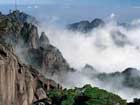| Videos | • Latest |
|
• Feature | • Sports | • Your Videos |
Anhui Province
For today's introduction of Chinese provinces, autonomous regions and municipalities, let's take a look at Anhui Province.
Anhui Province, located in eastern China, crosses the basins of the Yangtze and Huaihe River. It covers an area of nearly 140 thousand square kilometers, and has a population of 65 million people.
Anhui is full of tourist areas. It has nine national level key scenic spots. Mount Huangshan is well known for its scenery, sunsets, peculiarly-shaped granite peaks, pine trees and views of the clouds. It has been recognized as a UNESCO World Heritage Site.
Mount Jiuhua is one of the sacred mountains of Chinese Buddhism. The mountain is famous for its rich landscape, delicate beauty and ancient temples.
The two traditional villages of Xidi and Hongcun are also among China's major tourist destinations. They preserve to a remarkable extent the appearance of non-urban settlements that largely disappeared or have been transformed during the last century. Their streets, architecture, and the integration of houses with comprehensive water systems are unique surviving examples.
Anhui has a distinct cultural sphere. Huangmeixi, a form of traditional Chinese opera, is popular across the country. With its sweet melodies and lyrics, graceful sounds and movements, and beautiful costumes and sets, the opera also spreads its fame abroad.
Anhui also has a high concentration of traditional products: Xuan Paper and Hui Ink are traditionally considered the best types of paper and ink for Chinese calligraphy.
Anhui has great economic development potential. After years of large-scale construction, the province established a fast and readily accessed network of communications. Its blueprint for the 11th Five-Year Plan aims to build a sound and efficient economy. According to the plan, the average GDP growth rate will be more than 10 percent. By 2010, the province's GDP will exceed one trillion yuan, tripling the GDP from 2000.

 0 Comments
0 Comments







Comments